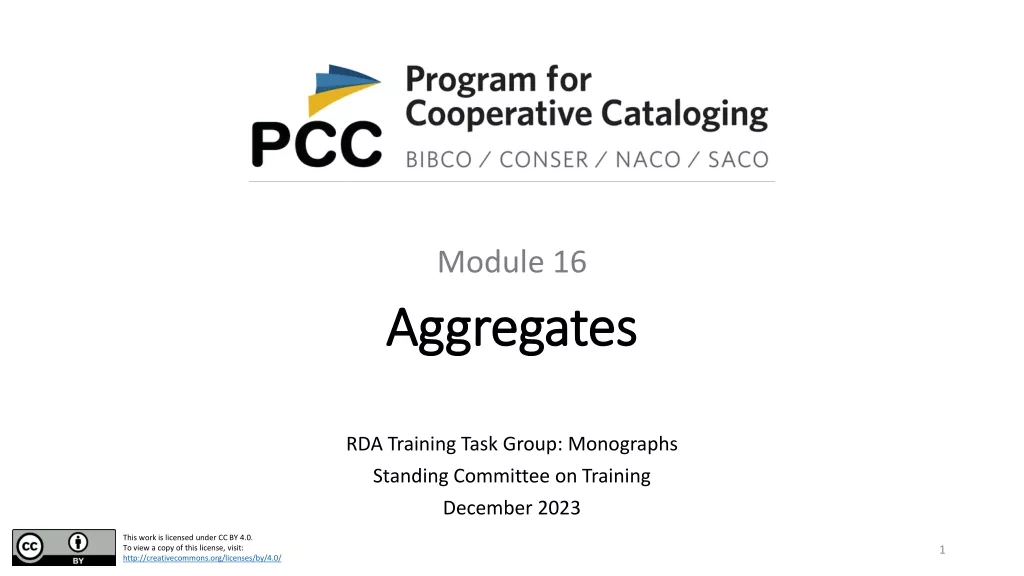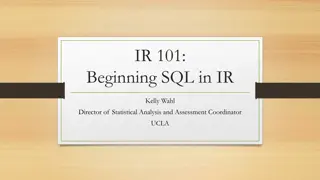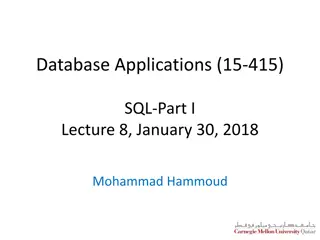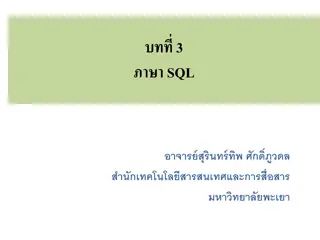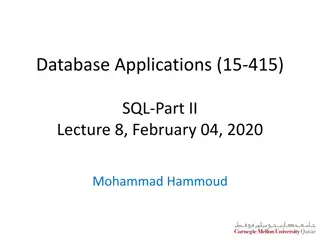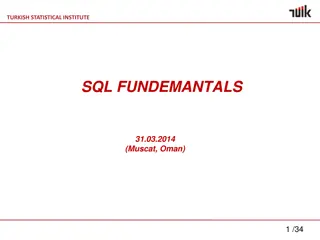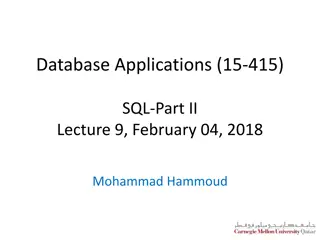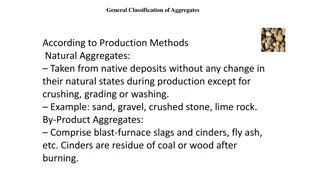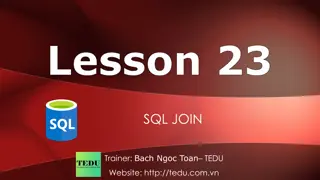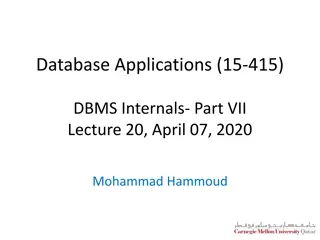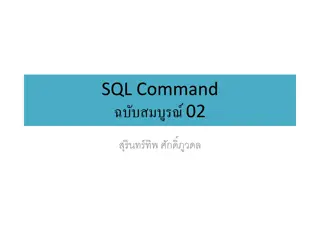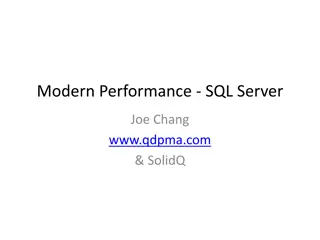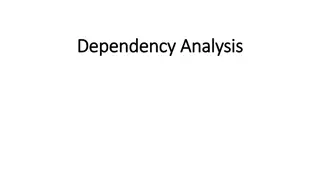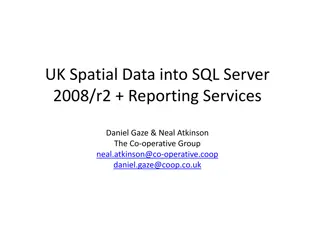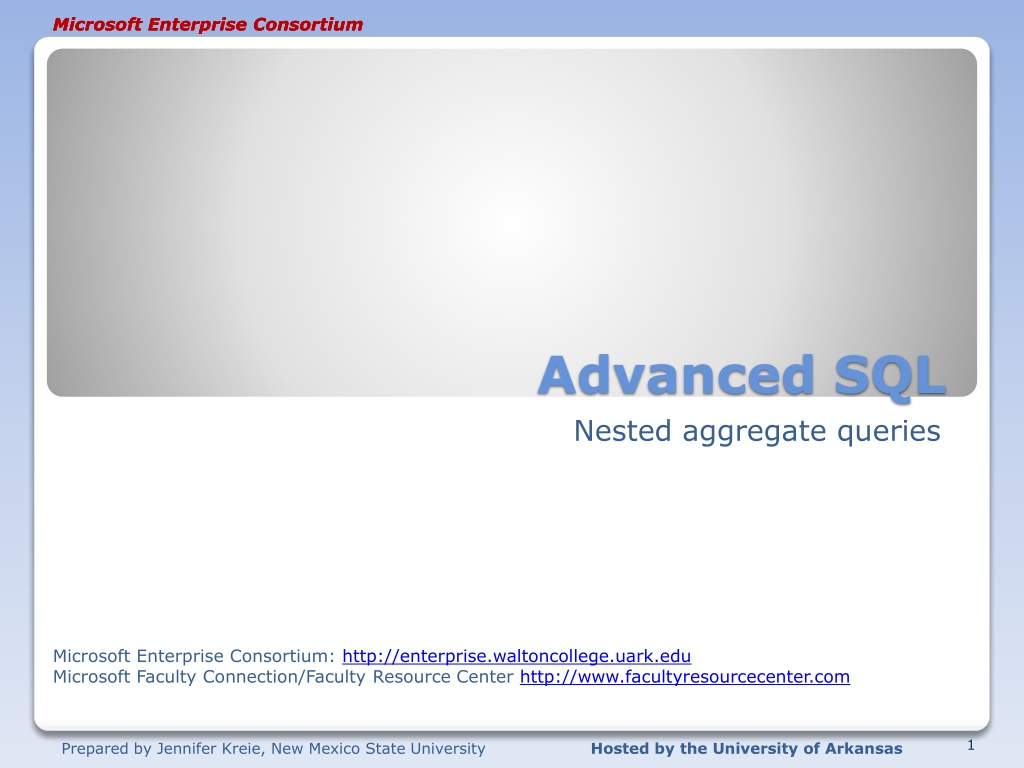
Nested Aggregate Queries in Microsoft Enterprise Consortium
Learn about nested aggregate queries in the Microsoft Enterprise Consortium, where you can embed one aggregate query inside another to solve complex problems efficiently. Explore detailed data examples and see how to use the CAST() function for data conversion.
Download Presentation

Please find below an Image/Link to download the presentation.
The content on the website is provided AS IS for your information and personal use only. It may not be sold, licensed, or shared on other websites without obtaining consent from the author. If you encounter any issues during the download, it is possible that the publisher has removed the file from their server.
You are allowed to download the files provided on this website for personal or commercial use, subject to the condition that they are used lawfully. All files are the property of their respective owners.
The content on the website is provided AS IS for your information and personal use only. It may not be sold, licensed, or shared on other websites without obtaining consent from the author.
E N D
Presentation Transcript
Microsoft Enterprise Consortium Microsoft Enterprise Consortium Microsoft Enterprise Consortium Advanced SQL Nested aggregate queries Microsoft Enterprise Consortium: http://enterprise.waltoncollege.uark.edu Microsoft Faculty Connection/Faculty Resource Center http://www.facultyresourcecenter.com 1 Prepared by Jennifer Kreie, New Mexico State University Hosted by the University of Arkansas
Microsoft Enterprise Consortium Microsoft Enterprise Consortium What you ll need Log in to MEC for this lesson and into MSSMS (Microsoft SQL Server Management Studio). Be sure to select your account ID under Database in the Object Explorer pane, similar to the example shown here. You should know the SQL covered in the SQL Fundamental series. If there is something besides the topics for this lesson that you re not familiar with in this presentation about nested aggregate queries, please review earlier lessons in the Advanced SQL presentations. 2 Prepared by Jennifer Kreie, New Mexico State University Hosted by the University of Arkansas
Microsoft Enterprise Consortium Microsoft Enterprise Consortium Nested Aggregate queries Sometimes it is necessary to embed one aggregate query inside another aggregate query, a.k.a. nested aggregate queries. As with other types of subqueries, the aggregate subquery decomposes the problem statement and creates a solution for part of the problem statement. 3 Prepared by Jennifer Kreie, New Mexico State University Hosted by the University of Arkansas
Microsoft Enterprise Consortium Microsoft Enterprise Consortium Nested Aggregate 1st: detailed data Using the greenhouse database, we will list crop- planting ID, crop, variety, and the yield count. NOTE: The way harvest data is recorded varies. Some harvests are weighed, others are counted. /* 1st: List detailed data about crop plantings and the harvest yield count. */ select CropPlantingID, crop, variety, cast(Yield_Count as decimal) as yld_count from tblcropVariety CV, tblcropPlanting CP, tblCropHarvest CH where CV.CropVarID = CP.CropVarID and CP.CropPlanting_ID = CH.CropPlantingID; Though not required, table aliases have been used here defined in the FROM clause and used in the WHERE clause. 4 Prepared by Jennifer Kreie, New Mexico State University Hosted by the University of Arkansas
Microsoft Enterprise Consortium Microsoft Enterprise Consortium Comment about the CAST() function In the query we just created the CAST() function is used to convert data stored as text to numeric data. The data types for columns in the greenhouse database may be revised in the future and you may not need to use the CAST() function to convert numbers stored as text to numeric values that can be calculated. select CropPlantingID, crop, variety, cast(Yield_Count as decimal) as yld_count from tblcropVariety CV, tblcropPlanting CP, tblCropHarvest CH where CV.CropVarID = CP.CropVarID and CP.CropPlanting_ID = CH.CropPlantingID; 5 Prepared by Jennifer Kreie, New Mexico State University Hosted by the University of Arkansas
Microsoft Enterprise Consortium Microsoft Enterprise Consortium 2nd: Aggregate data Using the previous query in the FROM clause, we now use the count and sum aggregate functions to count the number of crop plantings and sum the yield count. Note the table alias for the subquery. select crop, variety, count(cropPlantingID) as planting_count, sum(yld_count) as yield_sum from (select CropPlantingID,crop, Variety, cast(Yield_Count as decimal) as yld_count from tblcropVariety CV, tblcropPlanting CP, tblCropHarvest CH where CV.CropVarID = CP.CropVarID and CP.CropPlanting_ID = ch.CropPlantingID) CVPH group by crop, variety order by yield_sum desc; 6 Prepared by Jennifer Kreie, New Mexico State University Hosted by the University of Arkansas
Microsoft Enterprise Consortium Microsoft Enterprise Consortium 3rd: Aggregate data Using the previous query in the FROM clause, we now the count the number of crops (not plantings of each crop) and average the yield count. select crop_type, count(*) as "# of Crops Planted", avg(yield_sum) as "Avg Crop Yield Count" from tblCrop, (select crop, variety, count(cropPlantingID) as planting_count, sum(yld_count) as yield_sum from (select CropPlantingID,crop, Variety, cast(Yield_Count as decimal) as yld_count from tblcropVariety CV, tblcropPlanting CP, tblCropHarvest CH where CV.CropVarID = CP.CropVarID and CP.CropPlanting_ID = ch.CropPlantingID) cvph group by crop, variety) SubQ where tblCrop.Crop = SubQ.Crop group by crop_type order by crop_type; 7 Prepared by Jennifer Kreie, New Mexico State University Hosted by the University of Arkansas
Microsoft Enterprise Consortium Microsoft Enterprise Consortium 3rd: Aggregate data: Output Output: The IntelliSense feature immediately recognizes the use of a temporary (derived) table, i.e. the subquery table alias. 8 Prepared by Jennifer Kreie, New Mexico State University Hosted by the University of Arkansas
Microsoft Enterprise Consortium Microsoft Enterprise Consortium What was covered Nested aggregate queries When do you need a nested aggregate? Whenever you find yourself trying to do a function within a function, such as an average of a sum, you probably need a nested aggregate query. 9 Prepared by Jennifer Kreie, New Mexico State University Hosted by the University of Arkansas
Microsoft Enterprise Consortium Microsoft Enterprise Consortium Resources http://enterprise.waltoncollege.uark.edu/mec.asp Microsoft Faculty Connection Faculty Resource Center http://www.facultyresourcecenter.com/ Microsoft Transact-SQL Reference http://msdn.microsoft.com/en-us/library/aa299742(v=SQL.80).aspx AdventureWorks Sample Database http://msdn.microsoft.com/en-us/library/ms124659%28v=sql.100%29.aspx 10 Prepared by Jennifer Kreie, New Mexico State University Hosted by the University of Arkansas

